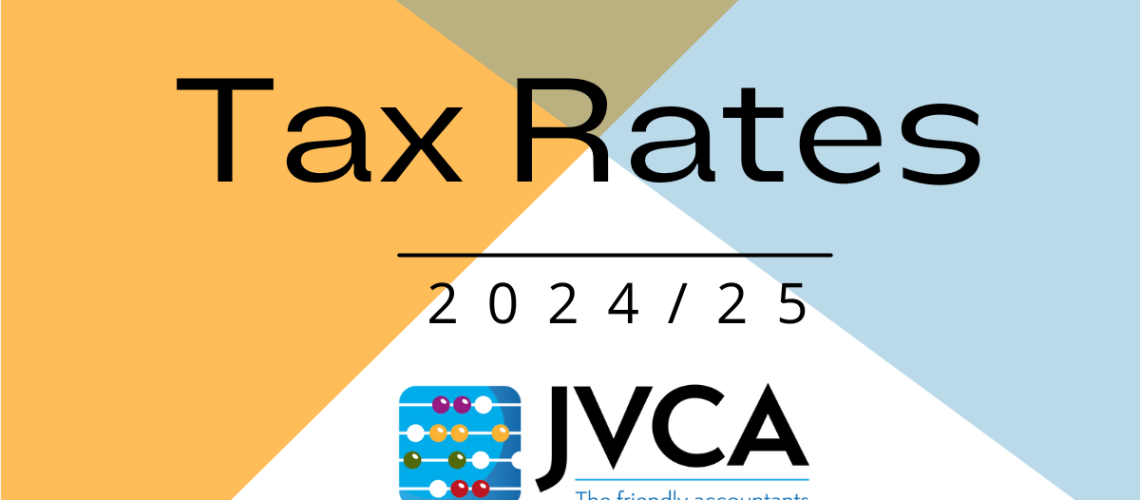What are the tax rates and allowances for April 2024 to April 2025? – this is our summary of the new tax rates following the Spring Budget 2024. Note this is the post budget data and includes: personal allowances, income tax rates, national insurances rates, capital gains tax rates, High Income Child Benefit tax charge, VAT registration and deregistration threshold, corporation tax rates and pension allowances.
Income tax rates
| Taxable income (not dividends and not Scottish residents) £ | Rate % | Tax £ | Cumulative £ |
| 2024/25 | |||
| Savings: 0–5,000 | 0 | Nil | Nil |
| 0–37,700 | 20 | 7,540.00 | 7,540.00 |
| 37,701–125,140 | 40 | 34,976.00 | 42,516.00 |
| Over 125,140 | 45 | – | – |
| 2023/24 | |||
| Savings: 0–5,000 | 0 | Nil | Nil |
| 0–37,700 | 20 | 7,540.00 | 7,540.00 |
| 37,701–125,140 | 40 | 34,976.00 | 42,516.00 |
| Over 125,140 | 45 | – | – |
Tax rates for dividend income
| Dividends within: | 2024/25 | 2023/24 |
| Basic rate band | 8.75% | 8.75% |
| Dividend allowance | £500 | £1,000 |
| Higher rate band | 33.75% | 33.75% |
| Dividend allowance | £500 | £1,000 |
| Additional rate band | 39.35% | 39.35% |
| Dividend allowance | £500 | £1,000 |
Personal allowances and reliefs
| 2024/25 £ | 2023/24 £ | |
| Personal allowance | 12,570 | 12,570 |
| Income limit for personal allowance | 100,000 | 100,000 |
| Allowances for couples: | ||
| Marriage Allowance | 1,260 | 1,260 |
| Married couples: minimum (born before 6 April 1935) | 4,280 | 4,010 |
| Married couples: maximum (born before 6 April 1935) | 11,080 | 10,375 |
| Income limit for married couples’ allowance, born before 6 April1935 | 37,000 | 34,600 |
| Blind person’s allowance | 3,070 | 2,870 |
| Rent-a-room relief | 7,500 | 7,500 |
| Trading income allowance | 1,000 | 1,000 |
| Property income allowance | 1,000 | 1,000 |
| Savings allowance – basic tax band | 1,000 | 1,000 |
| Savings allowance – higher tax band | 500 | 500 |
Pension allowances
| Tax year: | 2024/25 £ | 2023/24 £ |
| Annual Allowance (AA) | 60,000 | 60,000 |
| AA is tapered when adjusted income including pension contributions exceeds: | 260,000 | 260,000 |
| AND net income excluding pension contributions exceeds: | 200,000 | 200,000 |
| Minimum tapered Annual Allowance | 10,000 | 10,000 |
| Money purchase annual allowance (MPAA) | 10,000 | 10,000 |
| Lifetime Allowance | abolished | abolished |
Corporation tax rates
| Year from 1 April | 2024 | 2023 |
| Main rate | 25% | 25% |
| Small Profits Rate | 19% | 19% |
| Small Profits Rate where profits don’t exceed: | £50,000 | £50,000 |
| Marginal Relief Lower Limit | £50,000 | £50,000 |
| Marginal Relief Upper Limit | £250,000 | £250,000 |
| Standard fraction | 3/200 | 3/200 |
CGT rates and annual exemptions
| Tax Year | Annual exempt amount | Tax rate paid by | ||||
| Individuals, personal representatives (PRs) and trusts for disabled | General trusts | Individuals within: | Trustees and PRs | |||
| Basic rate band | Higher tax bands | |||||
| £ | £ | % | % | % | ||
| 2024/25 | 3,000 | 1,500 | 10 | 20 | 20 | |
| Residential property | 18 | 24 | 24 | |||
| Carried interest | 18 | 28 | 28 | |||
| 2023/24 | 6,000 | 3,000 | 10 | 20 | 20 | |
| residential property & carried interest | 18 | 28 | 28 | |||
A welcome reduction in the rate of capital gains tax on residential property
NIC rates and thresholds
NIC: Class 1 primary monthly thresholds
| Employee (primary) | 2024/25 £ | 2023/24 £ |
| Lower earnings limit (LEL) | 533 | 533 |
| Primary threshold (PT) | 1,048 | 1,048 |
| Upper earnings limit (UEL) | 4,189 | 4,189 |
NIC: Class 1 primary rates
| Employee (primary) | 2024/25 | 2023/24 from 6 Jan 24 | 2023/24 to 5 Jan 24 |
| Up to LEL | N/A | N/A | N/A |
| From LEL to PT | 0% | 0% | 0% |
| From PT to UEL | 8% | 10% | 12% |
| Above UEL | 2% | 2% | 2% |
NIC: Class 1 secondary monthly thresholds
| Employer (Secondary) | 2024/25 £ | 2023/24 £ |
| Secondary threshold (ST) | 758 | 758 |
| Upper secondary threshold for under 21s (UST) | 4,189 | 4,189 |
| Apprentice Upper secondary threshold (AUST) for under 25s | 4,189 | 4,189 |
| Veteran Upper Secondary Threshold (VUST) | 4,189 | 4,189 |
| Investment Zone Upper Secondary Threshold (IZUST) | 2,083 | 2,083 |
| Freeport Upper Secondary Threshold (FUST) | 2,083 | 2,083 |
NIC: Class 1 secondary rates
| Employer (Secondary) | 2024/25 | 2023/24 |
| Up to: ST, FUST, AUST, FUST, IZUST, VUST | 0% | 0% |
| Above: ST, UST, AUST, FUST, IZUST, VUST | 13.8% | 13.8% |
| Employment Allowance – annual amount per company / group | £5,000 | £5,000 |
No changes to national insurance for employers and a welcome saving in Employee national insurance.
NIC: Class 2 rates and thresholds
| Tax year | Flat rate per week (note 1) | Share fishermen per week | Volunteer development workers per week | Small profit threshold (note 2) | Lower profits threshold (note 3) | |
| £ | £ | £ | £ | £ | ||
| 2024/25 | 3.45 | 4.10 | 6.15 | 6,725 | N/A | |
| 2023/24 | 3.45 | 4.10 | 6.15 | 6,725 | 12,570 | |
Notes:
- Self-employed traders with profits below the small profits threshold do not have to pay class 2 NIC, but they are not entitled to a NI credit. They can pay class 2 NIC voluntarily.
- For 2022/23 and 2023/24 self-employed individuals don’t pay class 2 NIC if their annual profits fall between the small profit threshold and the lower profits threshold, but they are given an NI credit for the year.
- From 2024/25 onwards there is no liability to class 2 NIC for self-employed traders with profits above the small profits threshold, but all self-employed traders with profits above the small profits threshold are entitled to an NI credit.
NIC: Class 3 rates
| Tax Year | Weekly Rate £ |
| 2024/25 | 17.45 |
| 2023/24 | 17.45 |
No changes to the Class 3 NIC rates
NIC: Class 4 rates and thresholds
| Tax Year | Main rate | Additional rate | Lower profits limit | Upper profits limit |
| % | % | £ | £ | |
| 2024/25 | 6 | 2 | 12,570 | 50,270 |
| 2023/24 | 9 | 2 | 12,570 | 50,270 |
A welcome reduction in the rate of NIC for self-employed individuals – although not as big a saving as for employees.
VAT registration and deregistration limits
| Effective date | Registration turnover: £ | Registration exception: turnover not exceeding £ | Deregistration turnover £ |
| 1 April 2024 | 90,000 | 88,000 | 88,000 |
| 1 April 2017 to 31 March 2024 | 85,000 | 83,000 | 83,000 |
The VAT registration threshold is an issue for those businesses who are approaching it! This increase just moves the problem around and doesn’t deal with the ‘cliff edge’ and how it affects business.
High income child benefit charge (HICBC)
| Period child benefit received: | Lower income threshold £ | Upper income threshold £ |
| From 6 April 2024 | 60,000 | 80,000 |
| From 7 January 2013 to 5 April 2024 | 50,000 | 60,000 |
This high income tax charge change is a good thing – although the chancellor’s statement indicated more changes to come and that might be a negative change.
This post comes under the heading of boring, but important! If you would like more information about what any of these tax rates mean for you then please get in touch at [email protected]
get in touch






